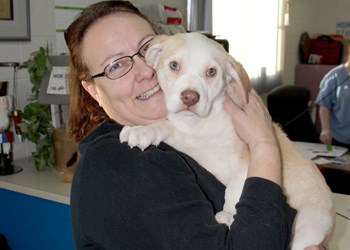Winter has arrived in Saskatchewan. With the cold weather settling in over the province, the SPCA reminds people to keep the animals of the community safe and secure.
Joan Kobylko with the SPCA says the most important thing to remember is that cold affects animals just as much as it affects people.
“If you’re cold when you’re outside, your dog is cold when it’s outside.”
Animals that have to be outside for extended periods require an insulated dog house, Kobylko says, this is the law in Saskatchewan.
“Whether you do that with a bale house, by surrounding a regular house with bales, or actually make an insulated dog house that has a dual compartment, that is required under the law for basic animal shelter.”
Just as people need to wear extra clothing for the outdoors, so too do dogs. Kobylko says that the pads of the feet are one of the areas that most need protection with cold streets. As well, just as people run the risk of freezing their ears in cold temperatures, ears on animals are also sensitive to cold.
It’s not just the cold that can harm animals in the winter months, however. Kobylko says one of the things that is incredibly dangerous to pets is anti-freeze, as it is highly toxic which kills animals but a substance that animals like to taste. As it becomes more necessary to use in winter, proper storage and just being aware of it dripping off vehicles is important. Salt, used to de-ice surfaces, is another thing that harms pets, being bad for their skin, bad for their feet, and unhealthy if they lick it and ingest it.
One thing everyone should be aware of is the need to “think and thump,” to hit the hood of your vehicle before setting off in the morning. The reason why you need to do this, Kobylko explains, is that engines are a source of heat and the city’s stray animals will climb into a car in order to get shelter in the cold and some warmth. The moving parts of an engine can be fatal to an animal which has climbed into a car, so it’s important to ensure they are not using your car as weather protection.
The cold weather is also the most dangerous time for animals to go missing, and Kobylko says that contacting the SPCA should always be the first step. Things like social media and contacting other rescues are also helpful, whether someone has found a pet or one has gone missing, but she says that the first step needs to be the SPCA because they are local pound, so animals go through their doors and as the first call will be the ones who have helpful information. While they don’t have an after-hours emergency, Kobylko says they’re easy to get in touch with and know the steps someone needs to take.
“The more you get it out there, the more likely you are to get your animal home, quickly and safely. But always, always start with your local pound.”
If people find animals who they believe are not being provided with what they need in the winter months, it is recommended that people contact their local SPCA, animal control officer, or local RCMP.
“That is not for the average Joe to decide upon, because you don’t know the conditions and you don’t know the situation under which it’s fallen, and nobody does on first glance. Should you be involved? Yes, as in phoning professionals who know how to follow the steps.”
The final recommendation is one that applies through the year, and that is to spay and neuter your pets. Kobylko says that she can never emphasize enough how important this is, because across the country rescues and shelters are over capacity and the only way to stop it is to spay and neuter.
“I can’t repeat it enough... There are only so many homes available, and if you think of our tiny little area and how many animal rescues have popped up, every animal rescue, every shelter, every SPCA, every humane society is full, all the time... The public needs to be smarter, be more responsible, and spay and neuter.”




